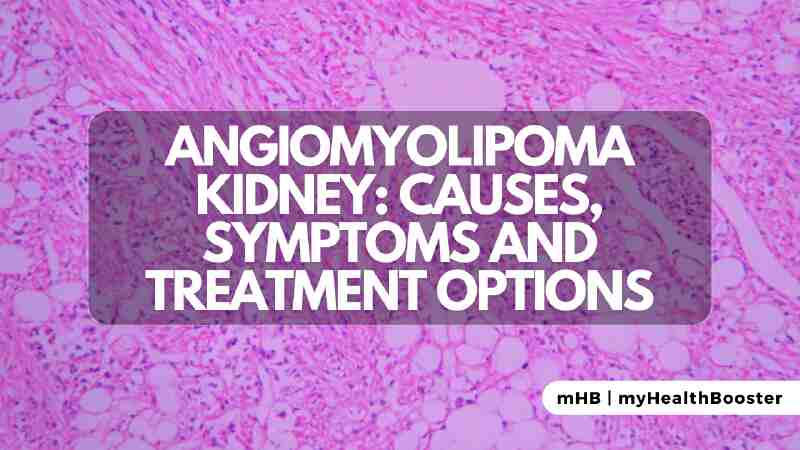Angiomyolipoma (AML) in the kidney is an uncommon benign tumor characterized by a blend of blood vessels, smooth muscle, and fat tissue. Frequently discovered incidentally, AMLs may grow, potentially causing pain or bleeding. Though mostly non-cancerous, large or symptomatic tumors may necessitate surgical intervention or embolization.
This article delves into the types, causes, symptoms, and treatment options for angiomyolipoma kidney.
Types of Angiomyolipoma Kidney
Angiomyolipoma kidney is categorized into three types based on the tumor’s composition of tissues and cells:
- Classic or Triphasic AMLs: Comprising smooth muscle tissue, fat, and blood vessels.
- Monophasic AMLs: Consisting of only one type of tissue, such as fat, blood vessels, or muscle tissue.
- Epithelioid Angiomyolipomas: Entirely composed of kidney blood vessels (epithelioid cells) and pose a higher risk of developing into a cancerous condition.
Causes and Risk Factors of Angiomyolipoma Kidney
The exact causes of angiomyolipoma kidney remain unclear, but researchers theorize that mutations in specific genes, particularly TSC1 and TSC2 tumor suppressor genes, play a role. These mutations impact the production of tuberin, leading to uncontrolled cell growth and tumor formation.
Symptoms of Angiomyolipoma Kidney
Angiomyolipoma kidney typically presents with no symptoms and may not necessitate treatment. However, in some cases, individuals may experience:
- Blood in urine
- Urinary tract infection (UTI)
- Pain in one side of the upper belly or flank
- Kidney failure
- Low red cell count or anemia
- A palpable lump or mass
While rare, life-threatening bleeding can occur, classifying the tumor as renal angiomyolipomas. However, the incidence of such severe bleeding is low, occurring in approximately 15% of cases.
Treatment of Angiomyolipoma Kidney
Many individuals with angiomyolipoma kidney may not require treatment, with decisions often based on tumor size, symptoms, and fertility considerations. Monitoring occurs regularly, and treatment options may include:
- Arterial Embolization: A minimally invasive procedure blocking blood flow to the tumor by injecting small particles into the arteries.
- Partial Nephrectomy: Surgically removing the diseased part of the kidney while preserving healthy tissue.
- Ablation Therapy: Employing techniques like radiofrequency or laser therapy to destroy tumors using heat or cold.
- Complete Nephrectomy: Surgical removal of the entire kidney, often necessary for larger tumors or when cancer has spread beyond the kidney.
Complications from treatment may include bleeding, scars, or infections, with a small risk of kidney failure after surgery. However, healthcare providers discuss these risks and formulate plans for managing potential complications.
Summary
Angiomyolipoma kidney presents a condition where permanent resolution is achieved through complete removal. This tumor, arising from unknown reasons or genetic mutations, may lack noticeable symptoms. Regular monitoring is recommended, and individuals experiencing symptoms should consult their healthcare provider to determine the appropriate course of action.
FAQs
- How do you reduce angiomyolipoma kidney?
- A. Early studies suggest Everolimus may effectively reduce hereditary angiomyolipomas, but its impact on common sporadic angiomyolipomas is inconclusive.
- Which food should you avoid if you have angiomyolipoma kidney?
- A. Foods like fast food, processed food, potatoes, salt, and certain meats are discouraged. Potassium and salt are particularly harmful.
- Will the angiomyolipoma kidney go away on its own?
- A. If treated, the condition may stabilize, and the tumor might shrink, but it is unlikely to disappear completely.
- What are the different treatment options available for Angiomyolipoma kidney?
- A. Treatment options include arterial embolization, partial nephrectomy, ablation therapy, and complete nephrectomy.
